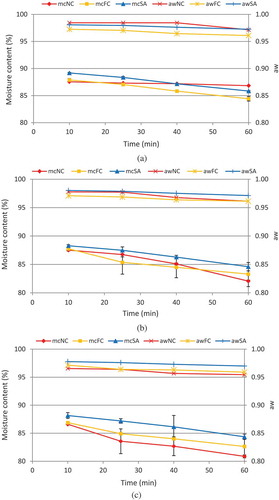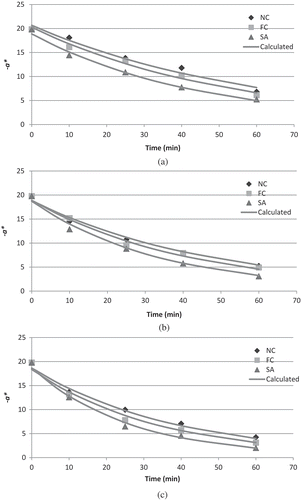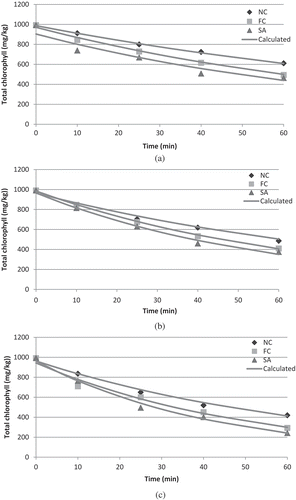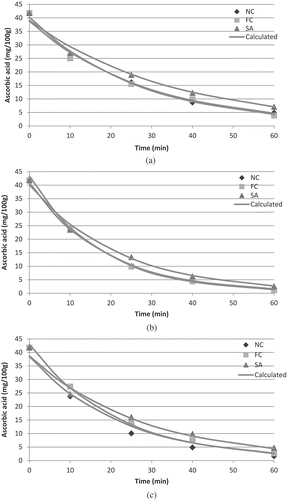ABSTRACT
Spinach was baked in steam-assisted hybrid ovens, natural and forced convection ovens, and saturated steam ovens at different temperatures and baking times. The moisture content, water activity, peroxidise activity, colour, ascorbic acid, and chlorophyll content were determined for each baking time and kinetic analysis of thermal degradation of the colour, chlorophyll, and ascorbic acid were evaluated. Degradation of green colour, total chlorophyll, and ascorbic acid in spinach leaves during the baking process was considered as first order reaction kinetics and temperature dependency of degradation was described by the Arrhenius equation. Baking in steam-assisted hybrid ovens resulted in the highest rate of reaction for both colour change and chlorophyll degradation, followed by forced convection and then natural convection ovens. The existence of steam in the baking chamber resulted in an acceleration of the baking process and better ascorbic acid retention in spinach was determined by baking in steam-assisted hybrid ovens. Degradation kinetics could allow definition of optimum baking temperatures and times in different types of ovens and shorter baking times should be preferred in steam-assisted hybrid ovens if fresh appearance (high greenness) is desired.
Introduction
Spinach (Spinacia oleracea L.) is a green leafy vegetable that can be consumed fresh or after being thermally processed. Spinach contains relatively high levels of bioactive compounds such as vitamin C, vitamin A, and minerals.[Citation1] These bioactive compounds contribute to various biological functions, for example, protection against mutagenesis, carcinogenesis, and aging. Vitamin C is a powerful antioxidant that participates in the scavenging of the reactive oxygen species, regenerating tocopherols from their radical forms, however, it can be lost during blanching or cooking.[Citation2] The high surface to volume ratio in comparison with the other vegetables makes spinach particularly susceptible to blanching which can cause 20–70% vitamin C loss.[Citation3]
The colour of spinach is mainly related to chlorophyll content, as this compound is the main pigment of green vegetables.[Citation4] Since colour is one of the most important quality attributes of vegetable products, numerous studies have been conducted to investigate the colour changes from bright green to olive brown and degradation of chlorophylls during heating.[Citation5,Citation6] The retention of chlorophyll during processing of vegetables depends upon the temperature and length of heat treatment.[Citation7] Chlorophyll and vitamin C content may be used for fresh-cut quality evaluation.[Citation8] Considerable losses occur in the quality and organoleptic properties of foods because of heating, so in this respect, accurate kinetic parameters, rate constants, and activation energy are necessary to design such processes, for having a safe product and a maximum retention of quality characteristics. Several researchers have published works on modelling of thermal degradation kinetics of colour, chlorophyll, and ascorbic acid in different vegetables under different conditions.[Citation9–Citation14] However, studies on degradation kinetics of quality factors of vegetables when baked in domestic ovens are quite limited. The objectives of the study were to compare the different domestic oven types with respect to quality characteristics of spinach and to conduct kinetic analysis of thermal degradation of colour, chlorophyll, and ascorbic acid under different baking conditions.
Materials and methods
Materials
Fresh spinach leaves were purchased from a local retailer, and transferred to the Ege University, Food Engineering Department Laboratory (Izmir/Turkey), and stored at 4°C. The experiments were conducted within 1 day from purchase.
Baking
Baking experiments were carried out in a steam-assisted (SA) hybrid oven (Arcelik, 9681 ESLTI) with dimensions of 48×43×25 cm, in a convection oven working in the mode of both natural convection (NC) and forced convection (FC) (Arcelik, KF 852 ESRI) with dimensions of 48×43×25 cm and also in a saturated steam oven (SS) (Arcelik, BF 840) having the dimensions of 19×39×33 cm. The steam-assisted hybrid oven used in this study is a hybrid oven having an inner steam generator mounted at the back panel of the oven. The steam generated from water (~350 g) was injected into the oven cavity in 5 min intervals (0, 5, 10, 15, and 20th minute of the cooking process), being started from the beginning of the baking process. The saturated steam oven is not installed with an electrical resistance in the oven cabinet; it can only supply heat by condensation of saturated steam during baking. Spinach samples in ceramic open cups (~140 g) were baked at 150, 170, and 190°C in a steam-assisted hybrid oven (SA) and convectional (FC and NC) ovens and at 100°C in a steam oven for 10, 25, 40, and 60 min. Each baking experiment was started with fresh samples in order to supply the same oven charge. Two ceramic cups of spinach sample were used in every run and positioned at the same place on the steel grid tray in the oven at each cooking interval. Two repetitions were carried out for the baking experiments.
Moisture content
The moisture content of spinach samples was determined gravimetrically in a vacuum oven (at 70°C, 2 days).[Citation15] The initial moisture content of spinach was found as ~89 (wet basis) g/100 g sample.
Water activity and colour
The water activity (aw) values of spinach samples were measured with a water activity meter (Testo AG 400, Lenzkirch, Germany), with a ±0.001 sensitivity. Colour determination was carried out using a Minolta Colorimeter (Minolta, DP-400) equipped with a standard illuminant D65 and L∗ (lightness; black = 0, white = 100), a∗ (redness and greenness; (redness, a* > 0; greenness, a* < 0) and b* (yellowness and blue; yellowness, b* > 0; blue, b* < 0) values were determined.[Citation16]
Ascorbic acid content
The principle of the method depends on the reduction of 2,6-dichlorophenol-indophenol redox dye by ascorbic acid and measurement of absorbance value of the unreduced dye, left in the medium, at 518 nm.[Citation17,Citation18] During the analysis, it was worked in solution containing oxalic acid (0.4%, w/v), to prevent autoxidation of ascorbic acid and provide the required acidity. The ascorbic acid content was calculated with the calibration curve that was made by using different concentrations (1–5 mg/100 ml) of stock vitamin C solution (0.1%, w/v).
Peroxidise activity
The peroxidise analysis was performed according to the method developed by Hart and Fisher[Citation19] as a qualitative analysis.
Chlorophyll content
The principle of the method depends on the extraction of chlorophyll a and chlorophyll b from the sample with 85% acetone solution, then the transportation of these compounds into ether phase and then performing spectrophotometric analysis at 660 nm (chlorophyll a) and 642.5 nm (chlorophyll b).[Citation15] The modified method can be detailed as follows: 1 g of spinach sample was mixed with 400 mg of CaCO3 and 20 ml of 85% acetone solution and homogenised using a blender. The mixture was filtered through black filter paper and the effluent was collected. Then, the filter paper was washed with 85% acetone solution and the effluents were mixed. It was filled with 85% acetone solution up to 50 ml. Twenty-five millilitres of this solution were taken to a separating funnel. It was added to 25 ml of distilled water and 30 ml of ether. The mixture solution was shaken in the funnel and centrifuged at 7500 rpm for 5 min for separation of phases. The aqueous phase was discarded. The ether phase was added to 50 ml of distilled water and 10 ml of ether, and then shaken again in the separation funnel. It was then centrifuged for 3 min and the aqueous phase was discarded. The same operation was repeated twice to remove the acetone from the solution and all the aqueous phase was discarded again. After these washing steps, the ether phase containing chlorophyll was taken and filled with ether up to 50 ml. A 20 ml part of that solution was taken and dried with anhydrous Na2SO4. The values calculated according to the below equations (Eqs 1, 2, and 3) modified from AOAC[Citation15] were multiplied by 100 to find out the chlorophyll content in spinach as mg/kg spinach sample.
where A660: Absorbance value at 660 nm; A642.5: Absorbance value at 642.5 nm.
Statistical analysis
The results were analysed using the SPSS 15.0 statistics package program (IBM Corp., New York, USA). The data were evaluated by one-way analysis of variance (ANOVA) with a Duncan significant difference test. Confidence level of p < 0.05 was applied to identify significant differences among the different baking conditions. Analyses of the kinetic data were performed using linear regression by MS Office, Excel. The mean absolute percentage deviation (P%) between the experimental and calculated values was calculated to validate the kinetic model, as given by Isleroglu et al.[Citation20]
Results and discussion
The moisture content (%) and water activity (aw) of baked spinach samples at different baking temperatures are illustrated in . The moisture content (%) and aw values of samples changed in a narrow range of 84–89% and 0.96–0.99, respectively. Moisture content and aw values of samples baked in different types of oven were not statistically different (p > 0.05). While slight reductions in both moisture content and aw values were observed depending on baking time in convectional and steam-assisted hybrid ovens, in saturated steam ovens no significant change with respect to moisture content and aw values was observed (p > 0.05). The average moisture content and aw values of samples during baking in saturated steam ovens were 88.9 ± 0.3% and 0.99 ± 0.00, respectively.
Figure 1. Moisture content (%) and water activity (aw) values of spinach during baking at (a) 150°C, (b) 170°C, and (c) 190°C.

Peroxidise is an enzyme conventionally used to monitor and evaluate the heat treatment efficiency since it is one of the most heat stable enzymes, occurring in a considerable number of vegetables. The results of peroxidise activity of baked spinach samples are given in , as positive or negative depending upon enzyme activity and used as an indicator of baking degree. It was observed that after 10 min of baking, peroxidise activity was negative (except in natural convection ovens at 150°C) for convectional ovens. However, in steam-assisted hybrid ovens no positive enzyme activity was determined at any baking temperatures. Similarly, in saturated steam ovens, no peroxidise positive sample was obtained for even 10 min of baking. Depending upon the similar results between saturated steam oven baking and steam-assisted hybrid oven baking; it can be said that existence of steam in the baking chamber may result in acceleration of the baking process. If the peroxidise activity was taken into consideration as an indicator of the baking degree of spinach leaves, it can be concluded that short baking times would be sufficient for steam-assisted hybrid ovens.
Table 1. Peroxidise activity of baked spinach.
The colour change of spinach samples were given as a* value in . All the colour parameters (L*, a*, b*) were determined, however, in the literature the a* value has been used as a physical parameter to represent greenness in colour measurement[Citation12,Citation21,Citation22] and also little difference was observed between fresh and baked spinach samples in terms of L* and b* values. Decrease in greenness (a* value) was observed with increasing baking temperatures and times (). Similar results were found in previous studies of Steet and Tong[Citation9] for peas and Ahmed et al.[Citation10] for green chilli puree and these heat-induced colour changes (from bright green to olive brown) are attributed to conversion of chlorophyll a and b to their respective pheophytins and further degradation to pyropheophytins. It was observed that a* values of spinach samples baked in steam-assisted hybrid ovens were lower than those baked in convectional ovens. Also, a* values of baked samples in saturated steam ovens had similar decreasing trend as baked samples in a steam-assisted hybrid oven.
Figure 2. Degradation of green colour (-a* value) in spinach samples during baking at (a) 150°C, (b) 170°C, and (c) 190°C.

A decrease in the total chlorophyll content was observed with increasing baking temperatures as in a* values (). During thermal processing the central magnesium in the chlorophyll ring is replaced by two hydrogen ions and green chlorophylls are converted to olive brown pheophytins so the quantity of chlorophylls retained during processing of vegetables depends upon temperature and length of heat treatment.[Citation7,Citation23] The total chlorophyll content of baked samples in saturated steam ovens were also decreased with increasing time and reached the lowest value of 285.8 ± 75.73 mg/kg.
Figure 3. Degradation of the total chlorophyll (mg/kg) in spinach samples during baking at (a) 150°C, (b) 170°C, and (c) 190°C.

Ascorbic acid content (mg/100 g) of spinach samples during baking at different temperatures is shown in . Ascorbic acid content decreased with increasing baking time and temperature and also significant difference was observed at baking temperature of 150°C in comparison with higher temperatures for all oven types (p < 0.05). Since ascorbic acid is very sensitive to temperature, the most reduction in ascorbic acid content was determined at baking temperature of 190°C. After 60 min of baking at 190°C, the ascorbic acid loss was 93.8% in steam-assisted hybrid ovens, 96.1% in natural convection ovens, and 97.3% in forced convection ovens. Better ascorbic acid retention was determined by steam-assisted hybrid ovens in comparison with convectional ovens. On the other hand, the lowest ascorbic acid level was observed when spinach baked in saturated steam ovens. This low ascorbic acid content can be attributed to high solubility of ascorbic acid in water which was generated by condensing steam on the surface of spinach.
Figure 4. Degradation of ascorbic acid (mg/100 g) in spinach samples during baking at (a) 150°C, (b) 170°C, and (c) 190°C.°

Degradation of green colour, total chlorophyll, and ascorbic acid in spinach leaves during the baking process followed first order reaction kinetics. shows the rate constants of these reactions with R2 and P% values. Baking in steam-assisted hybrid ovens resulted in the highest rate of reaction for both colour change and chlorophyll degradation, followed by forced convection and then natural convection oven baking. The degradation rate constants showed that the chlorophyll degradation is accelerated with steam injection and this can be attributed to the leaching of chlorophyll into water during baking of spinach in steam-assisted hybrid ovens. Also, a steam-assisted hybrid oven enabled increasing heating rates due to injected steam in the oven chamber and caused in the fast baking process. It can be also seen in , even at low baking temperatures (150 and 170°C) the spinach samples have already been baked in steam-assisted hybrid ovens for 10 min. If the faster heating rates of steam-assisted hybrid ovens compared to forced convection ovens, and that of forced convection ovens compared to natural convection ovens were taken into consideration, at the same baking time the samples baked in different oven types were exposed to different heat loads and baking degrees of samples were unequal. When considered from this point of view, shorter baking times should be preferred in steam-assisted hybrid ovens if the fresh appearance (high greenness) is desired.
Table 2. Reaction rate constants for degradation of green colour, total chlorophyll, and ascorbic acid with R2and P % values.
The calculated values of a*, total chlorophyll, and ascorbic acid contents using the kinetic rate constants, given in , are shown in , , and , respectively. The model fits well looking at the P% values, shown in . Temperature dependency of degradation of green colour, total chlorophyll content and ascorbic acid content was adequately described by the Arrhenius equation. The activation energies (Ea values) were calculated for colour degradation as 18.27, 18.54, and 21.21 kJmol−1 and for the total chlorophyll degradation as 22.81, 22.28, and 26.49 kJmol−1 for natural convection, forced convection and steam-assisted hybrid ovens, respectively. High activation energies signify greater heat sensitivity of green colour and total chlorophyll during baking in steam-assisted hybrid ovens as compared to natural and forced convection oven baking.
Ea values were calculated for ascorbic acid degradation as 17.68, 17.83, and 18.71 kJmol−1 for natural convection, forced convection, and steam-assisted hybrid ovens, respectively. The ascorbic acid degradation was not significantly affected by the oven type (p > 0.05).
Conclusion
Alternative cooking methods for spinach leaves such as baking in convectional, steam-assisted hybrid and saturated steam ovens were compared. A steam-assisted hybrid oven enabled increasing heating rates due to injected steam in the oven chamber and caused in the fast baking process. Better ascorbic acid retention was determined by steam-assisted hybrid ovens in comparison with convectional ovens due to the short baking times. However, the lowest ascorbic acid level was observed in spinach leaves baked in saturated steam ovens because of the high solubility of ascorbic acid into water generated by large amount of condensing steam. Also, degradation kinetics of the colour, chlorophyll and ascorbic acid would possibly allow definition of optimum baking temperatures and times at different types of ovens for spinach. The kinetic model might be used developing baking programs that can automatically control especially a new home scale steam-assisted hybrid, for the use of domestic consumers.
Acknowledgments
Equipment and material support of the companies of ARCELIK A.S. was acknowledged.
Funding
This research was supported by the Scientific and Technical Research Council of Turkey (Project No. TOVAG 109 O 087).
Additional information
Funding
References
- USDA. U.S. Department of Agriculture, Agricultural Research Service. USDA National Nutrient Database of Standard Reference 2005, Release 18.
- Smirnoff, N. Ascorbate Biosynthesis and Function In Photoprotection. Philosophical Transactions of the Royal Society of London B 2000, 355, 1455–1464.
- Favell, DJ. A Comparison of the Vitamin C Content of Fresh and Frozen Vegetables. Food Chemistry 1998, 62, 59–64.
- Kidmose, U.; Edelenbos, M.; Christensen, L.P.; Hegelund, E. Chromatographic Determination of Changes In Pigments In Spinach (Spinacia Oleracea L.) During Processing. Journal of Chromatographic Science 2005, 43, 466–472.
- Khachik, F.; Beecher, G.R.; Whittaker, N.F. Separation, Identification, and Quantification of the Major Carotenoid and Chlorophyll Constituents In Extracts of Several Green Vegetables by Liquid Chromatography. Journal of Agricultural and Food Chemistry 1986, 34, 603–616.
- Chen, B.H.; Chen, Y.Y. Stability of Chlorophylls and Carotenoids In Sweet Potato Leaves During Microwave Cooking. Journal of Agricultural and Food Chemistry 1993, 41, 1315–1320.
- Schwartz, S.J.; Lorenzo, T.V. Chlorophyll Stability During Continuous Aseptic Processing and Storage. Journal of Food Science 1991, 56, 1059–1062.
- Ninfali, P.; Bacchiocca, M. Parameters for the Detection of Post-harvest Quality In Fresh or Transformed Horticultural Crops. Journal of Food, Agriculture and Environment 2004, 2, 122–127.
- Steet, J.A.; Tong, C.H. Degradation Kinetics of Green Color and Chlorophyll In Peas By Colorimetry and HPLC. Journal of Food Science 1996, 61, 924–927.
- Ahmed, J.; Shivhare, U.S.; Debnath, S. Colour Degradation and Rheology of Green Chilli Puree During Thermal Processing. International Journal of Food Science and Technology 2002b, 37, 57–64.
- Nisha, P.; Singhal, R.S.; Pandit, R.S. A Study on the Degradation Kinetics of Visual Green Colour In Spinach (Spinacea oleracea L.) and the Effect of Salt Therein. Journal of Food Engineering 2004, 64, 135–142.
- Aamir, M.; Ovissipour, M.; Rasco, B.; Tang, J.; Sablani, S. Seasonality of the Thermal Kinetics of Color Changes In Whole Spinach (Spinacia oleracea) Leaves Under Pasteurization Conditions. International Journal of Food Properties 2014, 17, 2012–2024.
- Lima, J.R.; Elizondo, N.J.; Bohuon, P. Kinetics of Ascorbic Acid Degradation and Colour Change In Ground Cashew Apples Treated at High Temperatures (100–180°C). International Journal of Food Science and Technology 2010, 45, 1724–1731.
- Paul, R.; Ghosh, U. Effect of Thermal Treatment on Ascorbic Acid Content of Pomegranate Juice. Indian Journal of Biotechnology 2012, 11, 309–313.
- AOAC, Official Methods for Analysis, Association of Official Analytical Chemists, 15th ed. Vol II, Arlington, VA 1990.
- Abbott, J.A. Quality Measurement of Fruits and Vegetables. Postharvest Biology and Technology 1999, 15, 207–225
- Hışıl, Y. Instrumental analysis of Foods, Ege University. Engineering Faculty Edition Number: 45, Izmir-TURKEY 2004 pp 205–235
- Shrestha, N.; Shrestha, S.; Bhattarai, A. Determination of Ascorbic Acid in Different Citrus Fruits of Kathmandu Valley. Journal of Agricultural Science and Food Technology 2016, 2, 9–14.
- Hart, F.L.; Fisher, H.J. Modern food analysis; Springer: New York, 1971.
- Isleroglu, H.; Kemerli, T.; Sakin-Yilmazer, M.; Guven, G.; Ozdestan, O.; Uren, A.; Kaymak-Ertekin, F. Effect of Steam Baking on Acrylamide Formation and Browning Kinetics of Cookies. Journal of Food Science 2012, 77, 257–263.
- Francis, F.J.; Clydesdale, F.M. Green Vegetables. Food Colorimetry: Theory and Practise, The AVI Publishing Company: Westport, CT, 1975, 214–226.
- Ahmed, J.; Kaur, A.; Shivhare, U.S. Colour Degradation Kinetics of Spinach, Mustard Leaves, and Mixed Puree. Journal of Food Science 2002a, 67, 1088–1091.
- Gold, H.J.; Weckel, K.G. Degradation of Chlorophyll to Pheophytin During Sterilization of Canned Green Peas By Heat. Food Technology 1959, 13, 281–286.
